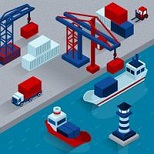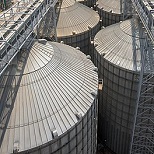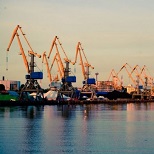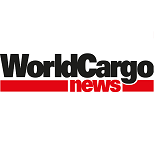26 января 2018 г.:
ru 4
en 2115 января 2018 г.:
ru 6
en 127 января 2018 г.:
ru 1
en 1 всего: 65228.12.17
Port dues differ in various countries and even in various ports of the same country, mainly for historical reasons. Port dues nature and amount depends mainly on certain demands of countries, regions, cities and ports themselves.
Port dues in Ukraine
Port dues system in Ukraine is set forth in the act called “Procedure of Port Dues Charging and Rates” approved by the Order of the Ministry of Infrastructure of Ukraine “On port dues” No. 316 dd. 27.05.2013, based on Article 22 of the Law of Ukraine “On sea ports of Ukraine” dd. 17.05.2012. It includes tonnage, berth, anchor, canal, light, administrative and sanitary.
Port dues may be classified by various features:
• fees for mandatory services required for vessel call at the sea port;
• fees without rendering any services to vessel.
The latter category apparently includes fiscal mandatory payments, but in fact it provides payment for using transport and port infrastructure, e.g. hydrotechnical facilities, water area with the berth vessel protection against sea heave, relevant depths, approach channels and waterways.
Port dues are aimed at the goals prescribed by the Procedure of Accounting and Using Funds from Port Dues approved by the same Order of the Ministry of Infrastructure of Ukraine, namely:
1. Tonnage dues shall be used:
• for operating the sea port water area and the berth operational water area and removal of alluvia and water surface/seabed pollutants;
• for maintenance, repair, updating, reconstructing and constructing breakwater and coast-protecting structures;
• for survey in the sea port water area and the berth operational water area;
• for ship-lifting and underwater technical operations in the sea port water area and the berth operational water area, including underwater research of seabed and lifting the lost (discharged) bulk items, vessel gear and rigging;
• for dredging related to maintenance, improvement, development (expansion) of the sea port water area and the berth operational water area;
• for taking measures aimed at navigation security at the waterways;
• for the National Search and Rescue System development and functioning in the Marine Search and Rescue Region of Ukraine.
2. Berth dues shall be used:
• for operating and maintenance of berthing facilities and adjacent territories;
• for repair, updating, reconstructing and constructing berthing facilities and adjacent territories.
3. Anchor dues shall be used:
• for operating and maintenance of vessel anchorage areas in the inner roadstead;
• for repair, updating, reconstructing and constructing vessel anchorage areas at the inner roadstead.
4. Canal dues shall be used:
• for operating, maintenance, repair and navigation security at the nationwide waterways and channels, removal of alluvia and maintenance of their dimensions in accordance with passport data;
• for dredging related to maintenance and/or improvement of the channel design dimensions;
• for operating, maintenance and repair of lighthouses, shore and floating navigation facilities at the channels;
• for constructing (purchase, manufacturing), updating, reconstructing and repair of channels and other facilities used for the above purposes;
• for operating other facilities used for constructing (purchase, manufacturing), updating, reconstructing, repair and maintenance of channels.
5. Light dues shall be used:
• for purchase, updating, reconstructing and constructing lighthouses, shore and floating navigation facilities, including in the inland waterways, technical (buoy, tug, special) floating craft and special hydrographic (buoy) vessels, software and hardware facilities of the water surface and navigation facilities monitoring systems;
• for operating, maintenance and repair of lighthouses, shore and floating navigation facilities, including in the inland waterways (except channel navigation facilities), technical (buoy, tug, special) floating craft and special hydrographic (buoy) vessels, software and hardware facilities of the water surface and navigation facilities monitoring systems with e-navigation facilities;
• for hydrographic works in order to update and to publish new navigation maps and navigation manuals in the responsibility area of Ukraine;
• for providing information to seafarers on changes in navigation hydrographic conditions;
• for drafting, developing and updating mapping products (maps, atlases, manuals etc.);
• for obtaining information about vessel calls.
6. Sanitary dues shall be used:
• for operating and maintenance of floating craft and container fleet used for receiving from vessels all types of pollutants (except ballast waters);
• for repair, updating and constructing principal facilities, floating craft and container fleet used for receiving from vessels all types of pollutants (except ballast waters);
• for operating, maintenance and repair of the sea port cleaning facilities or direct transfer of pollutants to cleaning enterprises;
• for operating, maintenance and repair of machinery used for handling solid petroleum products, garbage, food waste and other pollutants and their transportation to disposal areas;
• for operating, maintenance and repair of special port facilities used for disposal of garbage and other pollutants (garbage furnaces etc.).
7. Port dues shall be used:
• for reimbursement of indirect, overall, administrative, other operational and financing costs in compliance with the current legislation;
• for cost reimbursement of underwater hydrotechnical facilities (channels, berth operational water areas etc.) erected at the expense of private investments before the Law of Ukraine “On sea ports of Ukraine” entered into force, entered into the Register of Hydrotechnical Facilities in the manner prescribed by the law, transferred to state ownership in the manner and under the terms prescribed by the Cabinet of Ministers of Ukraine in compliance with the current legislation (except light dues);
• for reimbursement of business entities’ investments into the port infrastructure strategic facilities of state ownership in the manner and under the terms prescribed by the Cabinet of Ministers of Ukraine in compliance with the current legislation (except light dues);
• for maintenance of personnel engaged in the appropriate works, including for social security of such personnel.
Practical aspect
As stated above, port dues did not lose their target and essence for financing port economy and social industry, port-related territories and transport infrastructure.
Objective assessment of today situation regarding port dues regulation and administration shows that such industry faces a lot of problems, for instance, similarity of some types of port dues to other payments charged at the Ukrainian sea ports, problem of port dues amount and designated use.
Settlement of all the above issues in aggregate is a vital aspect for Ukraine, since facilitation of attractive investment climate both in the whole country and, inter alia, in port industry depends thereon. It may result in stable earnings from the Ukrainian product export by sea-going vessels as absolute majority of transported cargos.
Apart from the above issues of port dues regulation, practice faces also the issues of applying the relevant law provisions arising under dispute settlement, caused sometimes by unexpected circumstances.
One of such circumstances under which commercial courts considered two cases was vessel status determination: either international or cabotage vessel. Such dispute had a practical nature, since the applicable rate of berth dues depended on vessel status. Rates of berth dues applicable for international and cabotage sea-gong vessels differ tenfold. In the present cases difference amounted to hundred thousands UAH.
Both cases with the same background are described below.
In the 1st quarter 2016 a ferry arrived at the Chernomorsk Sea Port and moored at the ship repair yard’s berth for lay-up due to changing shipowner. For the whole lay-up period (less than one year) berth owner accrued berth dues which remained unpaid by new shipowners. The fact of two new shipowners for the whole lay-up period served as grounds for filing two claims.
In the process of court consideration, shipowners stated that berth dues were overestimated and calculated erroneously, since the ferry is an international sea-going vessel.
Having justified their position, shipowners stated that the fact of changing shipowner during the vessel lay-up period shall serve as grounds for changing vessel status from international to cabotage sea-going vessel. Shipowners’ arguments were based also on explanations of the state scientific research institution and state authorities entitled to perform state policy both in marine transport and marine transport security.
But neither instance (three instances under the first case and two instances under the second case) treated explanations of defendants and engaged persons as reasonable, so both claims were satisfied.
Commercial courts made decisions on the grounds of actual circumstances, such as ferry call at the Ukrainian sea port from the Georgian sea port and law provisions stipulated by the Merchant Shipping Code of Ukraine under which the vessel engaged in cargo transportation between sea ports of Ukraine and another state shall be deemed as international sea-going vessel.
But commercial courts ignored the fact of vessel re-mooring between different berths within the Ukrainian sea port water area, as the essential circumstance for vessel status determination. The defendants state that such circumstance evidenced the cabotage voyage.
In order to determine vessel status for the purpose of accruing port dues (in particular, berth dues), the court failed to take into consideration the fact of changing shipowner or vessel re-mooring within the same sea port water area, but took into consideration voyage conditions under the vessel call at the Ukrainian sea port.
Commercial courts also took into consideration the fact that the vessel owner was the state of Ukraine while shipowners were legal entities registered in Ukraine. But such fact had no impact on the court decision based on vessel status as engaged in international cargo transportation at the moment of her call at the Ukrainian sea port.
Summing-up the issues touched by commercial courts in the process of the above case consideration, we shall highlight importance of vessel status for the vessel owner, under which the vessel was returned to her owner by the shipowner – vessel operator. In particular, such vessel status shall serve as basis for accrual of port dues to be paid by the vessel owner.
Cases considered indirectly by commercial courts confirm vitality of determining the amount of port dues for international sea-going vessels. Such dues are so large that the shipowner is eager to initiate court proceedings under the alleged circumstances in order to avoid payment of such large port dues.
Therefore, practice of applying port dues in Ukraine confirms both correctness of tasks aimed at improving port industry competitiveness in the Ukrainian Sea Port Development Strategy till 2038 approved by the Order of the Cabinet of Ministers of Ukraine No. 548-р dd. 11.07.2013 and vitality of port industry reformation stipulated by the Order of the Cabinet of Ministers of Ukraine No. 634-р dd. 06.09.2017.
Conclusion
Shipowners are concerned with reducing disbursement costs which include port dues as a major share. The Ukrainian port economy reformation shall follow the same way. No doubt, the current law shall be complied with. Dura lex, sed lex.
Published at ports.com.ua
Authors:
Sharing is caring.

.jpg)

 November Transport, Shipping & Port News2020.12.04
November Transport, Shipping & Port News2020.12.04
 Opportunities in the Ukraine2019.07.10
Opportunities in the Ukraine2019.07.10 Endgame or a Path to Possibilities?2019.05.24
Endgame or a Path to Possibilities?2019.05.24
 A step in the right direction2018.08.27
A step in the right direction2018.08.27




 Odessa, 65014, Ukraine, 1 а, Gretska St
Odessa, 65014, Ukraine, 1 а, Gretska St
